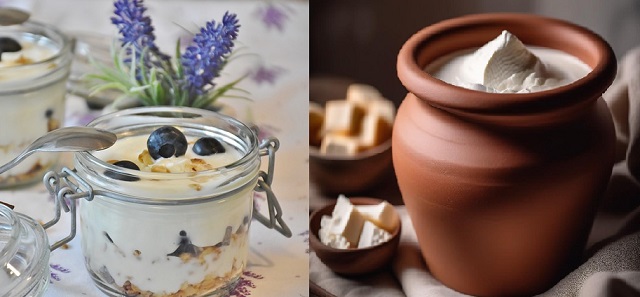At first glance, curd and yogurt might seem like the same thing, but they have some key differences in terms of preparation, bacteria, nutritional value, and taste. Here’s a breakdown:

Curd: Traditionally made in India and South Asia, curd is formed by curdling milk with acidic substances like lemon juice or vinegar. The resulting product is a soft, slightly tangy dairy product with a distinct flavour.
Yogurt: Yogurt is made by fermenting milk with specific bacterial cultures, typically Lactobacillus bulgaricus and Streptococcus thermophilus. These bacteria convert lactose (milk sugar) into lactic acid, giving yogurt its characteristic tangy taste and creamy texture.
Bacteria
- Curd: The bacteria present in curd are mainly lactic acid bacteria (LAB) produced naturally in the milk or introduced through the acidic substance. The types and amounts of LAB can vary depending on the region and traditional methods used.
- Yogurt: Yogurt contains specific strains of LAB, carefully chosen for their ability to produce lactic acid and beneficial properties. These strains are often commercially isolated and added to milk for consistent results.
Taste:
- Curd: Curd has a slightly tangy and mildly sour taste, often described as being “fresh” or “grassy.” The flavour can vary depending on the type of milk used and the length of fermentation.
- Yogurt: Yogurt has a tangy and creamy taste, with sweetness varying depending on the type (Yogurt is available in the market in many flavours such as plain, fruit-flavoured like mango, blueberry and pineapple, etc. but curd is generally unflavoured). The flavour profile can be more diverse due to the use of different bacterial cultures and additives.
Nutritional Value:
- Curd: Curd is a good source of calcium, protein, and probiotics. It is also relatively low in lactose compared to fresh milk, making it easier to digest for lactose-intolerant individuals.
- Yogurt: Yogurt is also rich in calcium, protein, and probiotics. It can be a good source of vitamin B12 and other essential nutrients depending on the type and fortification used.
| Nutrient | Yogurt | Curd |
|---|---|---|
| Calories | 59 kcal | 98 kcal |
| Protein | 10.4 g | 3.9 g |
| Fat | 1.5 g | 6.8 g |
| – Saturated Fat | 1 g | 4.3 g |
| Carbohydrates | 3.6 g | 3.6 g |
| – Sugars | 3.6 g | 3.6 g |
| Fiber | 0 g | 0 g |
| Calcium | 121 mg | 150 mg |
| Phosphorus | 97 mg | 110 mg |
| Potassium | 141 mg | 98 mg |
| Sodium | 36 mg | 40 mg |
| Vitamin B12 | 0.5 µg | 0.2 µg |
Both curd and yogurt are healthy and nutritious dairy products with similar benefits. The key differences lie in their preparation methods, bacterial cultures, nutritional profiles, and taste. Choosing one over the other depends on your personal preferences, dietary needs, and cultural background.

















Leave a Reply